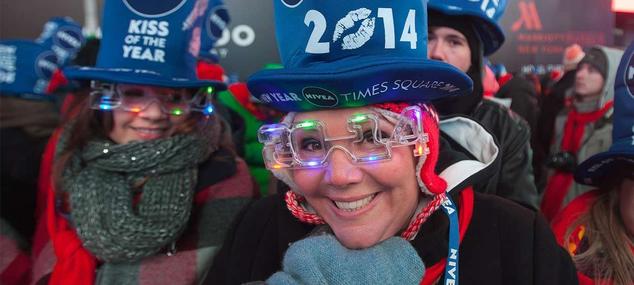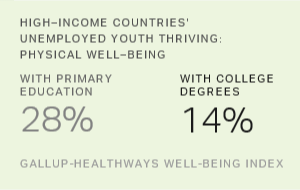Story Highlights
- U.S. uninsured rate drops nearly four points
- Using mobile technology outside of work linked to stress
WASHINGTON, D.C. -- Throughout the past year, Gallup has published nearly 90 articles about Americans' health and well-being. The Gallup-Healthways Well-Being Index uncovers new insights with its daily surveys, providing the most up-to-date data available on Americans' sense of purpose, social relationships, financial security, connection to community and physical health.
The following list represents Gallup editors' picks for the top 10 most important findings in 2014:
- Uninsured rate drops nearly four percentage points since late 2013: Gallup was among the first to report the decline in the U.S. uninsured rate, which coincided with the new requirement that Americans carry health insurance. The percentage of U.S. adults without health insurance was 13.4% in both the second and third quarters of 2014, down from 17.1% in the fourth quarter of 2013. This is the lowest quarterly uninsured rate measured since Gallup and Healthways began tracking it in 2008.
- Uninsured rate drops more in states embracing ACA: The uninsured rate among adults in the states that have chosen to expand Medicaid and set up their own exchanges in the health insurance marketplace has declined significantly more this year than among those in the remaining states that have taken one or neither of these actions. This finding suggests that adopting these components is critical to lowering the uninsured rate within states.
- Using mobile technology for work linked to more stress: Nearly half of workers who "frequently" use email for work outside of normal working hours (48%) report experiencing stress "a lot of the day yesterday," compared with 36% among those who "never" check work email outside of working hours. However, workers who email outside of normal working hours also rate their lives better than their counterparts who do not. The same patterns hold true for working remotely outside of working hours.
- Depression rates higher for long-term unemployed: About one in five Americans who have been unemployed for a year or more say they currently have or are being treated for depression -- almost double the rate among those who have been unemployed for five weeks or less. The long-term unemployed also spend less time with family and friends than other Americans. Gallup also found that Americans who have been out of work for a year or more are much more likely to be obese than those unemployed for a shorter time.
- U.S. veterans report less stress, worry than civilians: Although many veterans face very serious and unique mental health challenges, Gallup finds that among employed Americans, active-duty and veteran populations are more emotionally resilient than their civilian counterparts.
- In U.S., 14% of those aged 24 to 34 report living with parents: Young adults who live at home are significantly less likely to be married, to be employed full time and to have a college education than those who are the same age but don't live at home. Those aged 24 to 34 who live at home are also less likely to be "thriving" and have lower overall well-being than their peers who don't live with their parents.
- Obesity linked to lower social well-being: In terms of social well-being, obese Americans are the least likely of all weight groups to be thriving, while underweight individuals are the most likely to be suffering. This pattern underscores the risk of being at either extreme of the weight spectrum when it comes to social relationships.
- Older Americans feel best about their physical appearance: Two-thirds (66%) of Americans aged 65 and older agree that they always feel good about their physical appearance, compared with 61% of 18- to 34-year-olds. Middle-aged Americans (54%) are the least likely to report feeling good about their appearance. Blacks and Hispanics are much more likely than whites and, to a lesser extent, Asians to say they always feel good about their appearance.
- LGBT Americans report lower well-being: Americans who identify as lesbian, gay, bisexual or transgender (LGBT) trail their non-LGBT counterparts in all five elements of well-being: purpose, social, financial, community and physical. The disadvantage in overall well-being is starker for LGBT women than for LGBT men.
- Baby boomers are not maximizing their strengths at work: Although U.S. baby boomers have been in the workforce for many years, they are no more likely than younger generations to say that they are able to use their strengths to do what they do best throughout the day. About one in two baby boomers plan to delay their retirement, meaning they will remain an influential part of the workforce. Therefore, employers have an opportunity to help baby boomers identify and use their strengths to achieve higher performance outcomes.
Stay with Gallup.com for more discoveries in 2015.


